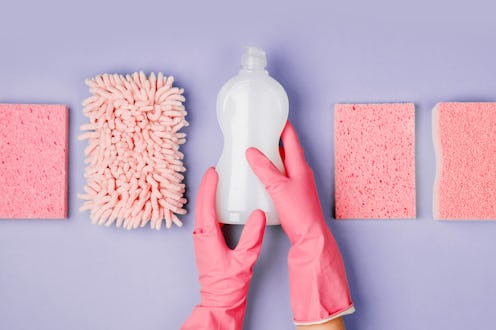(Living)
The Most Common Mistake Everyone Makes When Disinfecting Their Home

Over the past two months, it seems everyone has become a cleaning expert of sorts in their own right. You’ve scrubbed, wiped, and disinfected nearly every surface and door knob in your home — but what if you’re doing it wrong? It turns out that, according to experts, one false move (or product) could render your efforts ineffective. So how, then, does one effectively disinfect their home, you ask?
According to the Centers for Disease Control and Prevention (CDC), a thorough deep-cleaning and disinfection job is a multi-step process, especially if you’re looking to kill and prevent viruses and bacteria (like a coronavirus strain). According to the CDC’s website, one must first cleanse the area with soap and water or another detergent or natural solution (like vinegar), then use a household disinfectant, registered by the United States Environmental Protection Agency (EPA)
“The great thing about this list compiled by the EPA is that it tells you which surfaces the product can be used on, and how long to let the product sit for to effectively inactivate SARS-CoV-2 (and other, harder-to-inactivate viruses),” explains Dr. Lauren Weinand, M.D., medical writer and family medicine resident physician, in an email to The Zoe Report. “Once a virus is inactivated, it is incapable of causing infection or illness.”
For reference, this approved list of worthy disinfectants includes commercial items like Lysol Brand All Purpose Cleaner, Clorox Disinfecting Bathroom Cleaner, and Windex Disinfectant Cleaner, to name a few. “The CDC also supports using any household bleach you happen to have on hand,” says Dr. Weinand. “Just make sure it's not expired and dilute it properly before use (5 tablespoons or 1/3 cup bleach per gallon of water, or 4 teaspoons bleach per quart of water). Follow the manufacturer's instructions for application, and let it sit for at least a minute.”
Setting time for your solutions is actually a crucial key to success here, and a step people often miss as they rapidly scrub and wipe their home’s surfaces and common areas, says Dr. Weinand — among other things. “Having a false sense of security about using a disinfectant and forgetting to wash your hands often with soap and water for at least 20 seconds; not reading the disinfectant label directions for safe, effective use; using an inappropriate disinfectant for the surface you're trying to clean; not using enough of the disinfectant (the surface you're trying to clean should be visibly wet); and using a cleaning product instead of a disinfectant [are all common mistakes made in the process of disinfecting],” she explains.
Also, it's important to be mindful of following this two-step procedure on more than just your countertops. “Be sure to disinfect all surfaces that you and your loved ones touch often, such as your phone, computer, remotes, video game controllers, chargers, children's toys and books, doorknobs, handles, countertops, tables, desks, chairs, other furniture, microwave exterior, oven exterior, dishwasher exterior, washer and dryer exterior, stove knobs, light switches, and steering wheel,” says Dr. Weinand.
If you think you’re showing symptoms of coronavirus, which include fever, shortness of breath, and cough, call your doctor before going to get tested. If you’re anxious about the virus’s spread in your community, visit the CDC for up-to-date information and resources, or seek out mental health support.